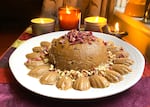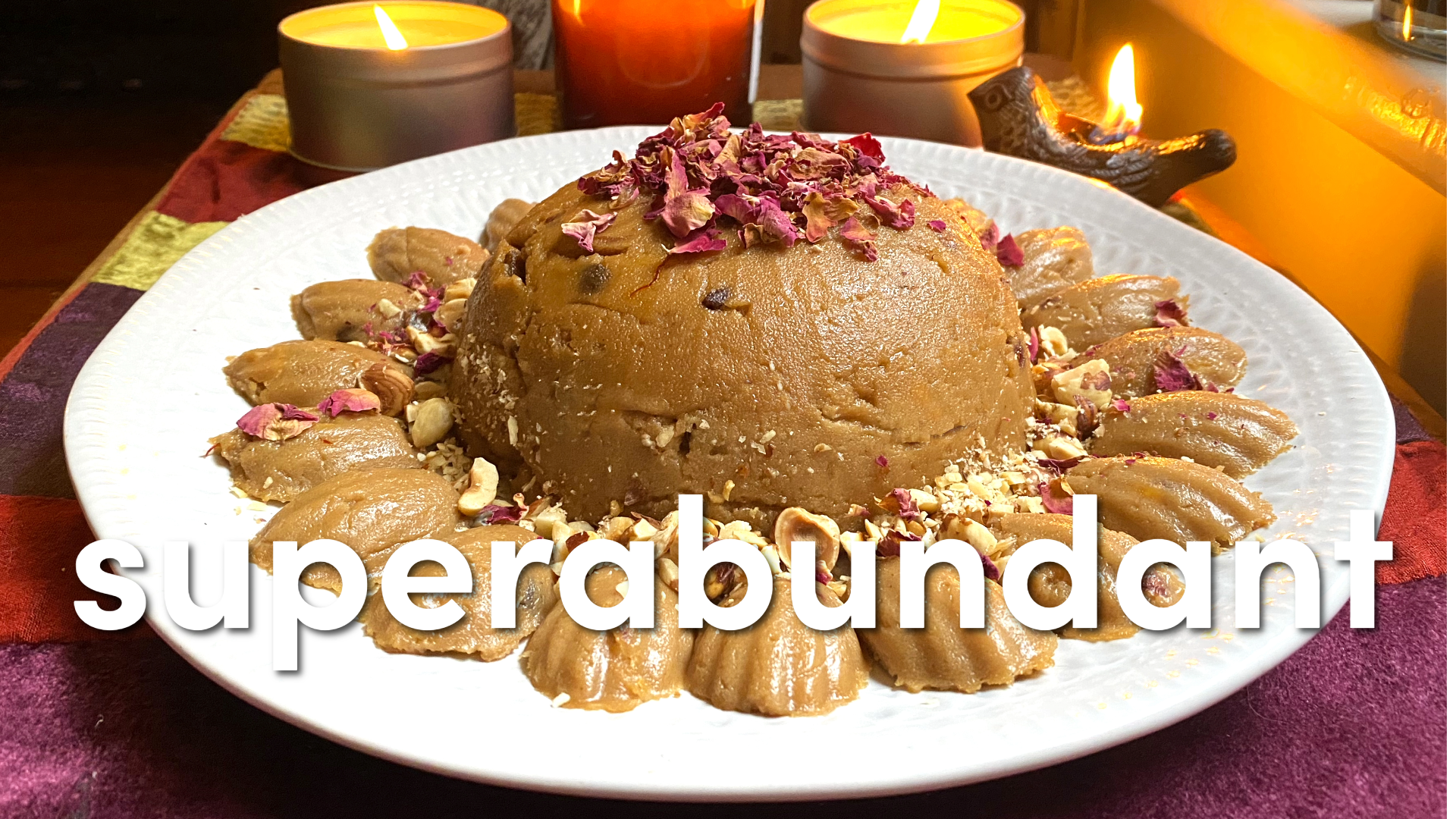OPB’s “Superabundant” explores the stories behind the foods of the Pacific Northwest with videos, articles and this weekly newsletter. To keep you sated between episodes, Heather Arndt Anderson, a Portland-based culinary historian, food writer and ecologist, highlights different aspects of the region’s food ecosystem. This week she offers a recipe for the Indian celebration sweet, suji ka halwa (semolina halva).
Click here to subscribe. For previous stories, go here.

Seemingly overnight, we went from the charming part of autumn — pretty leaves! shiny acorns! apples! — to the messy part. Now that the rains have set in, all those pretty leaves are clogging gutters and making the sidewalks a bit treacherous. We say, let the hunkering begin! Put on a pot of mulled cider, light some candles, and bring on the carbs. This week’s recipe will delight those with a taste for Indian sweets or anyone who grew up loving creamy wheat porridge for breakfast. Suji ka halwa is actually very similar to Cream of Wheat, but it’s made with semolina instead of wheat farina. What’s the difference between these two finely milled wheat products? Read on to find out!
Light-hearted holiday wishes, bitter is better (even on pizza!), burgers and fries and good things in markets
Freshly picked morsels from the Pacific Northwest food universe:
Wishing you a sweet Diwali
Sunday, Nov. 12 marks the beginning of the Hindu festival of lights — Diwali — and there are plenty of ways to observe the holiday. Eater Portland has a few suggestions for celebrations around Portland, and there’s another event with artist Renuluka Maharaj, complete with a dance party with DJ Anjali. If you elect to stay in and celebrate with loved ones, you can try the halwa recipe at the end of this newsletter.
RAD pizza party
Culinary Breeding Network is at it again, this time partnering up with Pizza Thief for an event that puts locally grown radicchio from Wild Roots Farm with everyone’s favorite triangular food. Stop by Pizza Thief this Sunday (Nov. 12) from 4-8 p.m., eat some pizza and check out the rad display.
A carbon-mootral burger is on the horizon
As The Guardian reported last month, the Swedish Environmental Protection Agency is recommending that seaweed be added to cattle feed to reduce methane — and Oregon scientists are already on the case. Last week we attended an event with Oregon State University’s Food Innovation Center to taste-test local seaweed-fed beef (which we are happy to report did not taste the least bit fishy). The cows were raised at Carman Ranch in Wallowa, Oregon, on a red algae feed additive produced by Symbrosia in Hawaii, and will be brought to market by Portland-based Neutral, the first carbon-neutral food company in America. This sensory panel builds on years of research and puts carbon-neutral beef one step closer to our plates. Watch this space as the story unfolds.
Pass the fries
First, the cheese surplus and now a surfeit of russets? Northwest News Network’s Anna King reports that Oregon potato growers overshot the runway to the tune of 5,000 acres of russet potatoes last year — that adds up to 165,000 tons of surplus this year. That’s a lot of totchos.
Good things in markets
This is the best time to stock your pantry, root cellar and fridge crisper drawers with long-storing cold season produce. Onions and potatoes aren’t the only vegetables for storage — we’re still seeing every winter squash variety imaginable. Bitterroot buttercup, Jarahdale and red kuri are our favorites for roasting and pies, and they also store well so you can stash them for eating throughout the season. Local apple season will soon be a wrap, so load up on late-season and winter storing varieties like Spitzenberg, Pink Lady, Elstar and Fuji. Dry beans harvested in September should be showing up in local markets too.
Look for fresh Brussels sprouts on the stalk and other crucifers like kohlrabi, kale and colorful cauliflowers. Radicchio, endive and chicory are as sweet and tender-crisp as they’ll ever be. Persimmons, quinces, and medlars are still going strong. Chestnuts are perfectly plump and shiny — but if you want collect your own, make sure you don’t confuse them with horse chestnuts, which are completely unrelated. While chestnuts are in the beech family, horse chestnuts are in the same plant family as maples and, of all things, lychees. (Fun fact: During World War I, the British government enlisted children to collect horse chestnuts for making acetone to produce the cordite needed for propelling bullets.)
If you’re planning on cooking a turkey for Thanksgiving, maybe try a heritage bird this year — they’re a more flavorful (and locally raised) alternative to the giant grocery store turkeys pumped full of salt water. A pheasant or guinea fowl is also lovely for smaller gatherings. It may seem a little soon for holiday meal shopping, but place your orders now — smaller poultry farms sell out early.
Recipe: Suji ka halwa (semolina halva)

Suji ka halwa (Indian semolina halva) for Diwali
Heather Arndt Anderson / OPB
Our favorite thing about every holiday is the special foods we share that make us feel at home. We reached out to our colleague Prakruti Bhatt to find out what she likes to eat for the Hindu festival of lights, and she said her favorite is suji ka halwa — a fudgy, cardamom-scented confection made from semolina, milk, ghee and a rich sugar syrup. Since it includes nuts, we opted to Oregon-ize it with local hazelnuts (cashews or pistachios are more traditional) and zhuzh it with saffron and rose petals. The best thing about this Indian dessert is that it’s wholesome enough to eat for breakfast. (In fact, if you were the kind of kid who dumped a ton of sugar, butter, and milk on their Cream of Wheat every morning, it might taste somewhat familiar — but farina is made from hard wheat and semolina comes from durum wheat.) To make this vegan, substitute the milk with your favorite unsweetened plant-based milk and use vegan margarine or coconut oil instead of ghee. Makes about 4 cups of halwa.
Note: If you want it to look a little fancier, pat the halwa into a bowl or other molds and allow it to cool to room temperature before unmolding, then sprinkle on the rose petals and nuts. You could also form the halwa into bonbons and roll them in crushed nuts and rose petals.
Ingredients
1 ½ cups water
1 ½ cups milk
1 cup (6 ounces) jaggery (or panela, or other unrefined sugar)
1 pinch saffron threads (optional)
½ cup ghee or butter
1 cup fine semolina
Pinch salt
¼ tsp cardamom
¼ cup chopped hazelnuts + 1 tbsp for garnish
¼ cup chopped dried fruit (such as golden raisins, barberries, chopped dried apricots, etc.)
2 tbsp dried rose petals
Instructions
- Bring the water and milk to a simmer in a medium saucepan over medium-low heat, then add in the jaggery and stir until the sugar has dissolved. Turn off the heat and add the saffron.
- In another medium saucepan over medium-low heat, melt the ghee and then stir in the semolina. Stirring the entire time, cook the semolina until golden brown and fragrant, about 6 or 7 minutes.
- Slowly whisk in half of the milk-sugar-saffron mixture until fully incorporated (it’ll sputter!), then add the rest of the liquid with the salt and cardamom. Keep stirring to keep the halwa from getting lumpy, and cook until the liquid is absorbed and the halwa is very thick and fudgy, about 2-3 more minutes.
- Mix in the ¼ cup of hazelnuts and the dried fruit until evenly distributed, then transfer to a serving dish and sprinkle with the rose petals and remaining hazelnuts.

